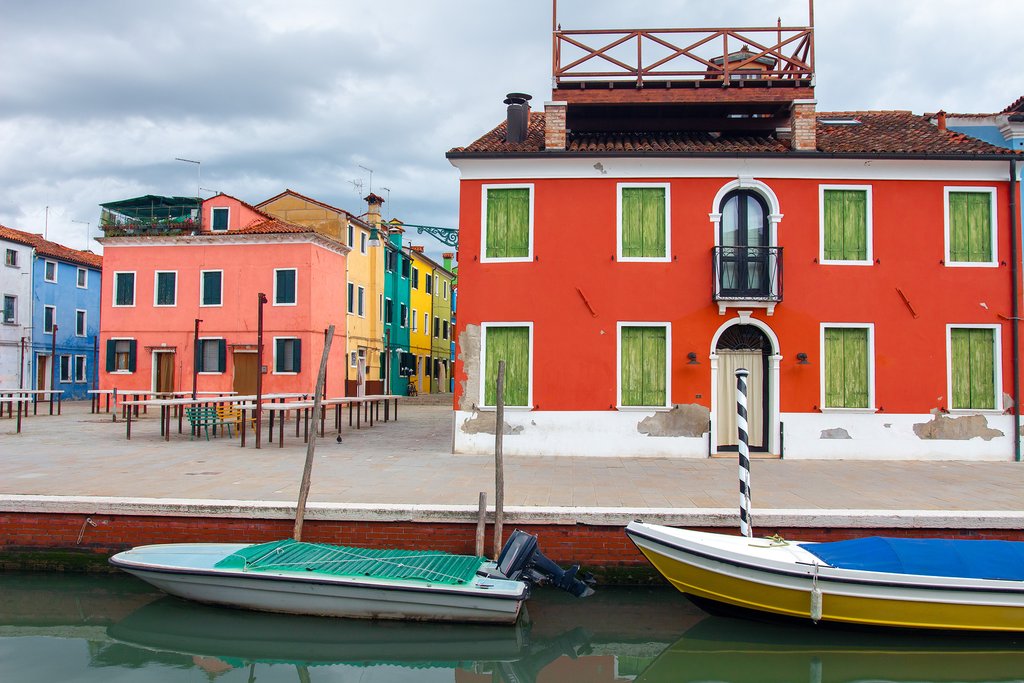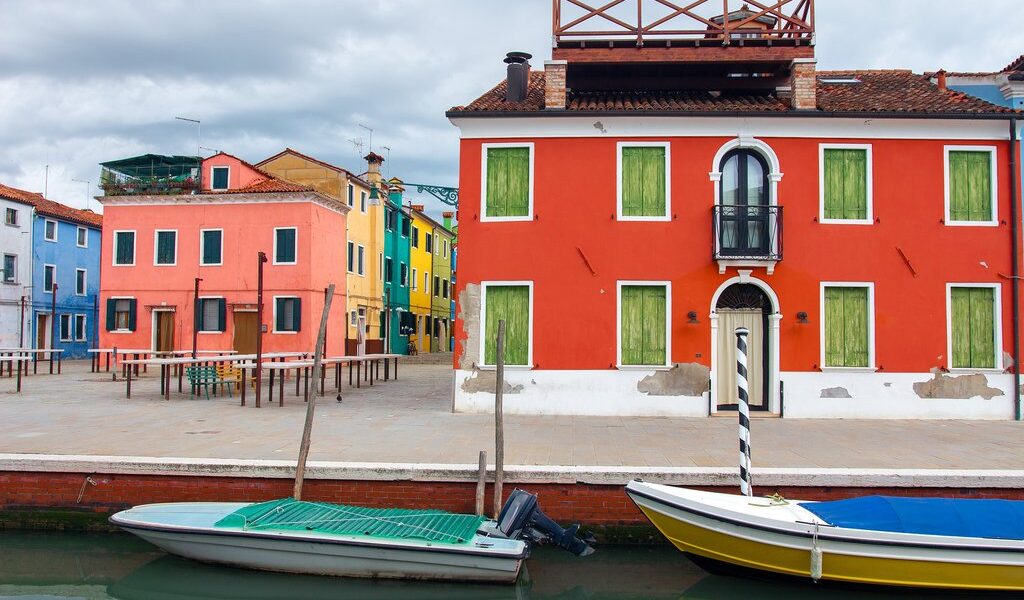
After you’ve marveled at the Grand Canal and St. Mark’s Square, what’s next? A short boat ride from central Venice, the island of Murano has long been famous for its glass. Lace is the claim to fame of tiny Burano, and bucolic Torcello contains the huge Basilica di Santa Maria dell’Assunta. Learn more in our guide to island-hopping in Venice.
## Unveiling the Enchanting Venetian Islands: A Journey Beyond the Grand Canal
Venice, a city celebrated for its iconic landmarks like St. Mark’s Square and the Rialto Bridge, possesses a treasure trove of secrets hidden within its surrounding lagoon. Beyond the bustling heart of the city lies a constellation of islands, each with its own unique character, history, and allure. Murano, Burano, and Torcello are just the beginning of this captivating archipelago. Embarking on an island-hopping adventure in the Venetian lagoon requires a deeper understanding of what awaits you on each distinct isle. Prepare to delve into the heart of these enchanting destinations, discovering what to expect, where to venture, and how to meticulously plan your unforgettable exploration.
## Crafting Your Island-Hopping Itinerary: Essential Planning Tips
Navigating the waters between the outer Venetian islands is best accomplished by utilizing the city’s efficient and readily available *vaporetto* (waterbus) service. These public transport vessels offer a cost-effective and reliable means of traversing the lagoon. While private water taxis offer a more personalized experience, it’s important to note that their fares tend to be significantly higher, making them a less budget-friendly option for most travelers.
Individual vaporetto tickets, valid for a generous 75 minutes after validation, are priced at Euro 7.50 per trip. These tickets can be conveniently purchased from automated machines or dedicated kiosks situated at the various vaporetto stops scattered throughout the city. Before boarding any vaporetto, remember the crucial step of validating (stamping) your tickets in the readily available yellow machines located on the docks. Failure to validate your ticket can result in a substantial fine, so be sure to comply with this essential regulation.
Alternatively, you can purchase tickets directly from the conductors on board the vaporetti. However, it’s imperative to locate and approach the conductor immediately upon boarding to avoid potential penalties. For visitors intending to utilize the waterbus service extensively, a more economical option is to invest in the 24-hour ACTV travel card, priced at Euro 20. Furthermore, 2- and 3-day cards are available for Euro 30–40 respectively, providing even greater value for extended travel. If your plans include a day trip to the Lido, consider the special Euro 13 return ticket designed specifically for this route.
### Maximizing Your Island Exploration: How Many Islands Can You Conquer?
While it is theoretically possible to visit Murano, Burano, and Torcello in a single, action-packed day, a more relaxed and immersive experience would involve spreading your exploration over two days. A recommended itinerary would include dedicating one day to exploring Murano and San Michele, followed by a second day to discover the charms of Burano and Torcello, or perhaps venture further to the serene San Francesco Del Deserto. For those seeking sun and sand, the Lido warrants a full day of its own, although a visit to the Lido can be conveniently combined with a trip to San Lazzaro.
### Charting Your Course: Navigating to and Around the Venetian Islands
The Fondamente Nove waterbus stop, situated on the northern side of the city, serves as the primary departure point for a variety of destinations, including Murano, Burano, Torcello, Lazzaretto Nuovo, and San Michele. Waterbus lines nos. 4.1 and 4.2 facilitate the journey to Murano, making a convenient stop at San Michele along the way. To reach Burano, Line no. 12 departs from Fondamente Nove every 30 minutes. Upon arrival at Burano, transfer to the shuttle boat (Line 9) for a short ride to Torcello. This connecting service is carefully timed to align with the arrivals from Venice, ensuring a seamless transition. To access the Lido, utilize waterbus lines nos. 1, 2, 5.1, 5.2, and LN, all of which traverse the lagoon from the San Zaccaria–Danieli stop near San Marco.
Once you’ve reached your chosen island, you’ll find that all are easily navigable on foot. However, it’s crucial to meticulously check the schedule for the next island-to-island departure and your return to Venice to avoid spending excessive time waiting for connections. For those seeking a more structured experience, guided tours of most of these islands are readily available.
## Delving Deeper: Unveiling the Unique Character of Each Venetian Island
### Finding Serenity on San Michele
For those seeking solace and tranquility in the early hours, San Michele offers a unique experience. Even as Venice awakens at 7:30 am, this serene island, a short vaporetto ride from Fondamente Nove, provides a haven of peace. Serving as the city’s cemetery since 1807, San Michele’s towering walls and lush, park-like grounds create an incredibly atmospheric setting. Apart from the occasional groundsman tending to the greenery and a few mourners paying their respects, you’ll likely find yourself immersed in solitude. Take a moment to honor the legacies of Ezra Pound, Joseph Brodsky, Igor Stravinsky, and Sergei Diaghilev, the renowned Russian ballet impresario, whose tomb is often adorned with ballet shoes.
### Witnessing the Art of Glassblowing on Murano
Murano’s identity has been inextricably linked to glassmaking for centuries. In 1291, Venetian glassmakers were mandated to relocate to the island, a mere 10-minute journey north of Fondamente Nove, due to the ever-present threat of fires. Today, its numerous *fornaci* (kilns) continue to produce exquisite vases, bowls, glasses, and a diverse array of intricate glass sculptures.
Many studios offer complimentary demonstrations of mouth-blown glassmaking, providing a captivating glimpse into this ancient art form. Almost all studios feature attached showrooms where you can purchase a variety of glass products. While these items may not be inexpensive, and shipping costs can nearly double the price, acquiring glass on Murano is often more cost-effective than purchasing similar items elsewhere, including Venice itself. To gain a deeper understanding of the island’s rich history of glassmaking, visit the Museo del Vetro (Museum of Glass), which offers a comprehensive overview of the craft.
### Immersing Yourself in the Colors of Burano’s Canals
Exploring the charming back streets of Burano is an experience unlike any other in Venice. Unlike the grand palazzi of Venice, Burano is characterized by tranquil canals adorned with brightly painted, low-slung homes of the Buranesi fishermen. While the men of Burano were occupied with their fishing endeavors, the women dedicated themselves to the intricate art of lace-making. Over time, lace-making became the island’s defining characteristic, and although the production of authentic handmade pieces has decreased, the craft remains a vital part of the island’s identity. A visit to the Museo del Merletto (Museum of Lace Making) provides an insightful look into the history of lace-making on Burano.
As an island community deeply connected to the sea, seafood plays a significant role in Burano’s culinary landscape. Trattoria al Gatto Nero, affectionately known as the “Black Cat,” has been serving up delectable Adriatic turbot and sea bass, Burano-style risotto (made with *ghiozzi*, a long-bodied fish from the lagoon), and tagliolini with spider crab since 1946. Trattoria da Romano, another popular seafood establishment adorned with works of art donated by visiting painters since the 1940s, has attracted a diverse clientele, including celebrities such as Sylvester Stallone, Keith Richards, and Philippe Starck. For those with a sweet tooth, be sure to sample the donut-shaped butter biscuits known as “buranelli,” which are ubiquitous throughout the island.
### Following in Hemingway’s Footsteps on Torcello
Ernest Hemingway, the celebrated author, held a deep affection for Torcello, often boating over to the tranquil island to indulge in food, drink, and writing. It’s difficult to imagine now, but Torcello was once a bustling city during the Middle Ages. Today, it comprises a collection of ancient buildings connected to the waterbus landing by a path along a single canal. Along the way, you’ll encounter Locanda Cipriani, Hemingway’s beloved bar/trattoria, established in 1935 by Giuseppe Cipriani. The island’s most notable attraction is the towering Basilica di Santa Maria dell’Assunta, renowned for its magnificent 11th- to 12th-century Byzantine-style mosaics.
### Journeying Back in Time on San Francesco del Deserto
San Francesco del Deserto, a small island located near Burano, is not accessible by the waterbus network, adding to its unique charm. Stepping onto this island is akin to stepping back into the 13th century, as it remains largely untouched by tourism. Surrounded by salt marshes and enveloped in cypress trees, the island is almost entirely occupied by a Franciscan monastery, where St Francis himself is said to have stayed. To reach San Francesco del Deserto, you’ll need to arrange for a private boat from Fondamenta del Pizzo in Burano, costing approximately Euros 10 per person return (including waiting time). Upon arrival, simply ring the monastery doorbell, and one of the friars will provide you with a tour (conducted in Italian; English pamphlets are available; closed on Mondays).
### Uncovering the History of Lazzaretto Nuovo, the “Hospital Island”
Vaporetto no.13, with stops made “on request,” provides access to Lazzaretto Nuovo, another peaceful island with a poignant history. In 1468, it was designated as the “lazaretto” of Venice, serving as a quarantine zone for individuals afflicted with leprosy, plague, and other deadly diseases. Abandoned in the 1970s, many of the island’s historic buildings and fortifications, constructed during the Napoleonic wars, remain. Free guided tours, the only means of exploring the island, are conducted from April to October, exclusively on Saturdays and Sundays, at 9:45 am and 4:30 pm.
### Exploring the Armenian Monastery on San Lazzaro
The small southern lagoon island of San Lazzaro degli Armeni, meaning “Saint Lazarus of the Armenians,” is dominated by the still-active Mekhitarist monastery, a congregation of Armenian Catholics. The Armenian connections are particularly enlightening, offering insights into the island’s cultural heritage. Visitors can also tour the attractive gardens and visit the “Lord Byron Room,” where the Romantic poet studied in 1816. A plaque outside the monastery commemorates Byron as a “devoted friend of Armenia, who died for the liberation of Greece.”
### Enjoying a Beach Day at the Lido
While the Lido may have lost some of its former glory as a prominent European resort, it remains Venice’s primary beach destination, a seven-mile sandbar separating the lagoon from the Adriatic Sea. The island offers two main beach areas: Bucintoro, located at the opposite end of the Gran Viale from the waterbus landing (a 10-minute walk), and San Nicolò, situated approximately one mile from the waterbus terminal and accessible by bus B.
While lounging on the beach is a popular activity, the restored Ancient Jewish Cemetery, established in 1386, is a worthwhile attraction. It’s important to note that although the Venice Film Festival takes place on the Lido every September, the island tends to become chilly, windswept, and often deserted from October to April.
B-1378

